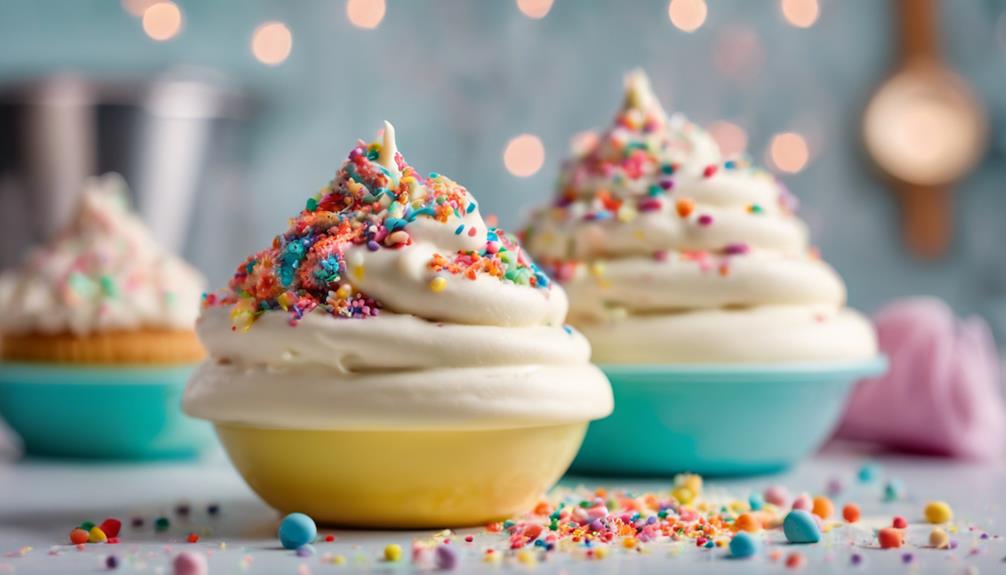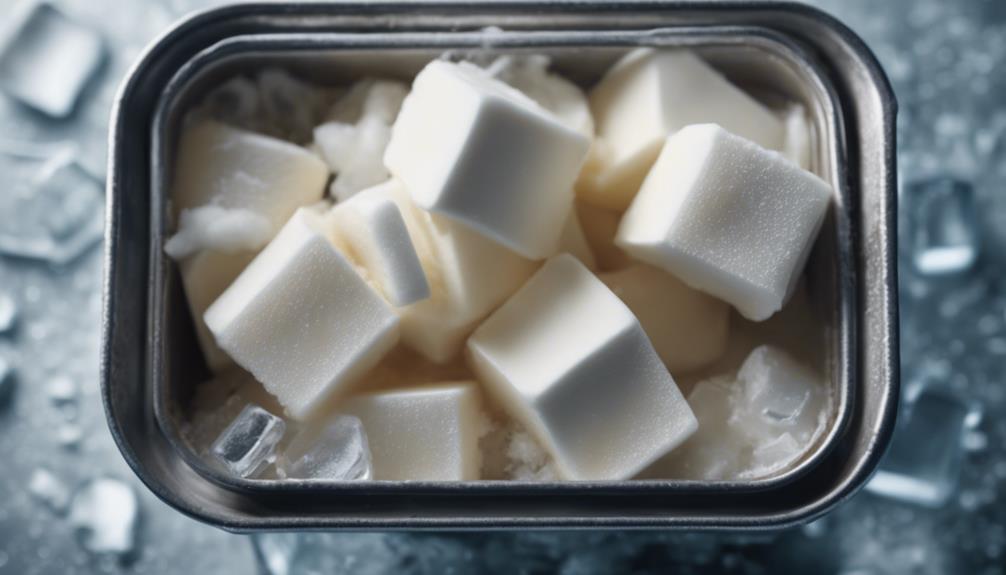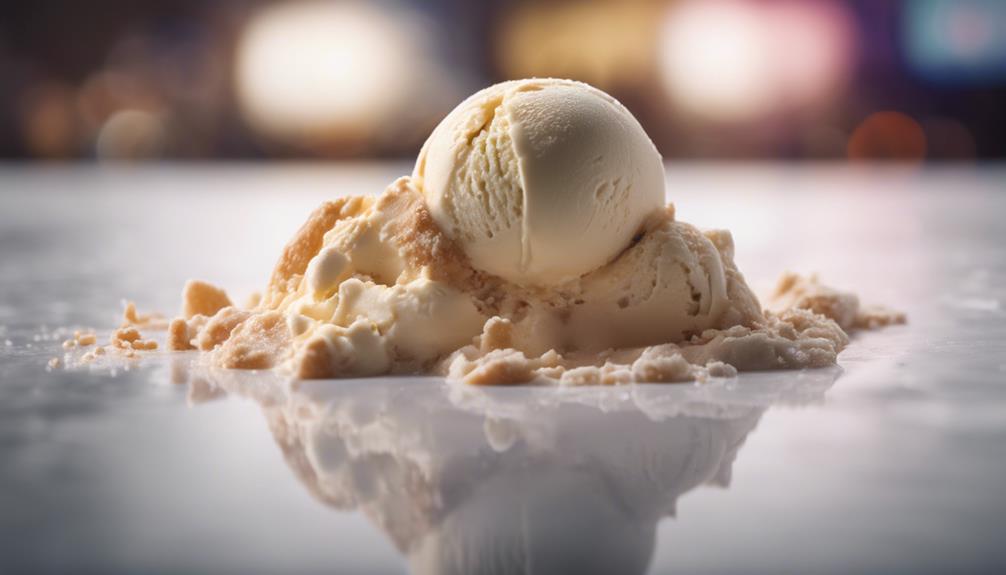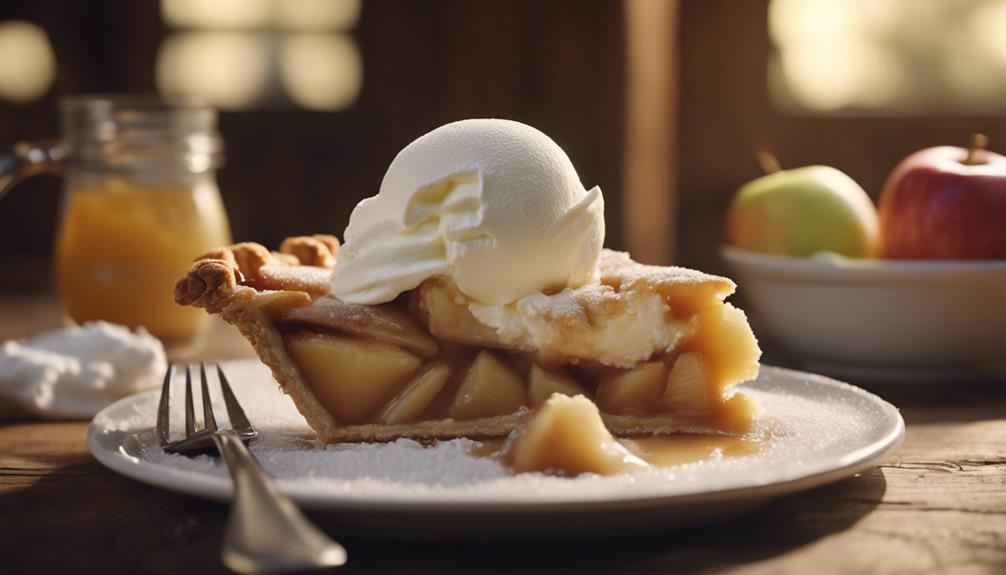Cake Batter Frozen Yogurt is a guilt-free way to satisfy your sweet cravings. Using simple ingredients like yogurt, cream cheese, honey, and dry cake mix, you can create this delicious treat in just 5 minutes. Once everything is blended together, allow it to freeze for at least 6 hours to achieve the perfect scoopable texture. Add sprinkles or fresh fruit for an extra burst of flavor. This low-calorie dessert packs in about 14 grams of protein per serving, making it a satisfying and nutritious option. Looking to step up your dessert game even more? There’s more to discover!
Key Takeaways
- Cake Batter Frozen Yogurt is a quick, 5-minute recipe that serves four people for a guilt-free dessert option.
- Key ingredients include yogurt, cream cheese, honey, and dry cake mix, creating a creamy, sweet flavor.
- The mixture needs to freeze for at least 6 hours for the best scoopable texture.
- Customize with toppings like sprinkles, fresh fruit, or sauces for added flavor and visual appeal.
Recipe Overview
Cake Batter Frozen Yogurt offers a delightful blend of tangy yogurt and sweet cake flavors, making it a quick and creamy dessert you can whip up in just 5 minutes. This frozen yogurt recipe is perfect for satisfying your sweet tooth without the guilt. You'll love how simple it's to create a rich and indulgent treat that serves four people.
The process is incredibly straightforward. You'll blend plain yogurt, cream cheese, honey, and vanilla extract until smooth, then pour in colorful sprinkles for that fun cake batter touch. In no time, you've got a luscious mixture ready for freezing. Just pop it in the freezer for a minimum of 6 hours, and it transforms into a scoopable delight.
One of the best things about Cake Batter Frozen Yogurt is its versatility. You can customize it with various mix-ins and toppings to suit your taste preferences. Whether you add chocolate chips, nuts, or more sprinkles, you can make this dessert your own.
Ingredients List
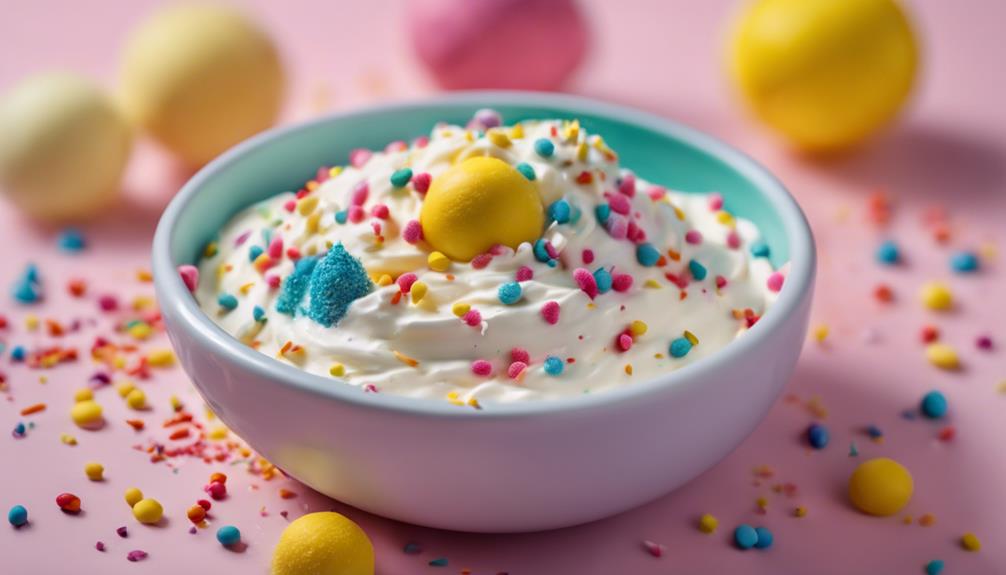
To make Cake Batter Frozen Yogurt, you'll need a few key ingredients: 1 cup of plain yogurt, 1 cup of cream cheese, and 3 tablespoons of honey. These base ingredients create a creamy and delicious frozen yogurt that tastes just like cake batter!
In addition to those, you'll want to include 3/4 cup of dry cake mix for that authentic cake flavor. You can choose yellow, white, or funfetti to suit your taste. Here's a handy table to help you gather everything you need:
| Ingredient | Amount | Notes |
|---|---|---|
| Plain Yogurt | 1 cup | Use full-fat or fat-free |
| Cream Cheese | 1 cup | Can substitute with dairy-free |
| Honey | 3 tablespoons | Adjust sweetness to taste |
| Dry Cake Mix | 3/4 cup | Choose your favorite flavor |
| Sprinkles | 3 tablespoons | For decoration and fun! |
Optional ingredients like 1/4 cup of sugar and 1 teaspoon of almond extract can enhance the flavor but aren't necessary. Enjoy creating your own cake batter frozen yogurt!
Preparation Steps
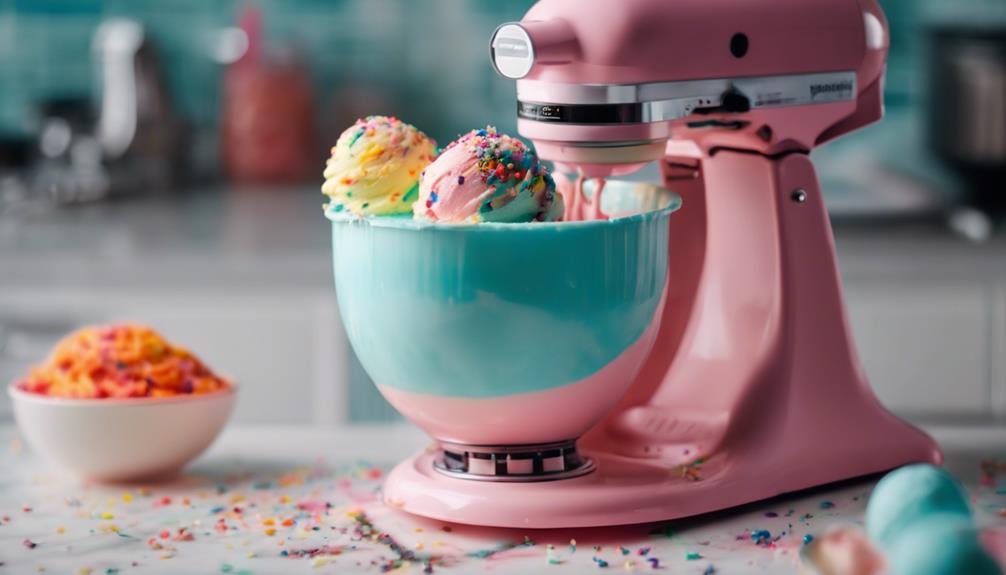
Begin by blending the yogurt, softened cream cheese, honey, and vanilla extract in a food processor until the mixture is smooth and creamy. Make certain the yogurt is at room temperature; this helps achieve a better blend.
Once your base is ready, gently fold in 3 tablespoons of sprinkles using a spatula. Be careful not to break the sprinkles as you mix them in; you want to keep that fun cake batter look.
Next, transfer your creamy cake batter frozen yogurt mixture into an airtight container. It's important to freeze it for at least 6 hours, but overnight is even better for the ideal texture. This waiting period allows the flavors to meld beautifully and guarantees a delightful creamy consistency when you scoop it out later.
When you're ready to enjoy your cake batter frozen yogurt, scoop it out right away for the best texture. It's delicious on its own, but feel free to add more sprinkles or fresh fruit on top for extra flair. Enjoy your sweet treat!
Serving Suggestions

When serving your cake batter frozen yogurt, you've got plenty of fun options to choose from.
You can use colorful bowls or cones to make it visually appealing, and don't forget about toppings like sprinkles or fresh fruit to elevate the flavor.
Pairing it with melted chocolate or whipped cream can turn your treat into an indulgent delight.
Bowl or Cone Options
Serving cake batter frozen yogurt in bowls offers a classic dessert experience, while cones add a playful twist for outdoor fun.
When you choose bowls, you get the benefit of easy customization. You can pile on your favorite toppings, like sprinkles, fruits, or syrups, without worrying about them spilling over. It's a perfect option for those who want to take their time and savor each bite.
On the other hand, cones make for a portable treat, ideal for summer parties or picnics. They're fun to hold and eat, adding a casual vibe to your dessert. If you're concerned about portion control, opt for smaller dessert bowls or mini cones to satisfy your sweet tooth without overindulging.
You can even create a colorful dessert bar where guests can choose between bowls and cones. This way, everyone can personalize their cake batter frozen yogurt experience to their liking.
Whether you prefer the classic bowl or the whimsical cone, both options deliver delicious fun and make for a memorable treat. Enjoy your cake batter frozen yogurt, whichever way you decide to serve it!
Topping Ideas Galore
Elevate your cake batter frozen yogurt experience with a variety of fun and delicious toppings that add texture and flavor. You can start by sprinkling in chocolate chips or crushed cookies for a delightful crunch.
For a colorful touch, don't forget to add rainbow sprinkles or even edible glitter—these toppings not only taste great but also make your frozen yogurt visually appealing.
If you're craving something rich, drizzle warm chocolate or caramel sauce over your yogurt. This adds a decadent contrast to the sweetness of the cake batter flavor and takes your treat to the next level.
Consider serving your frozen yogurt in waffle cones or bowls, crowned with a generous dollop of whipped cream for that classic dessert experience.
If you're feeling adventurous, try using different nut butters or yogurt-based dips as toppings. They'll provide a creamy twist that complements the cake batter perfectly.
With these topping ideas, you can customize your frozen yogurt to suit your cravings and impress your friends. So, grab your toppings and let your creativity shine!
Pairing With Fresh Fruit
Pair fresh fruit with your cake batter frozen yogurt for a deliciously invigorating contrast that enhances both flavor and texture. The sweetness of the cake batter yogurt pairs beautifully with the natural tartness and freshness of fruits, creating a balanced and satisfying treat.
Consider these fantastic fruit pairings:
- Strawberries: Their bright flavor and juicy texture complement the creamy yogurt while adding a rejuvenating touch.
- Blueberries and Raspberries: These fresh berries not only boost visual appeal but also pack a punch of antioxidants and vitamins.
You can also elevate the experience by drizzling honey or sprinkling granola on top, adding extra crunch and flavor.
Serving your cake batter frozen yogurt in a bowl with a side of fresh fruit makes for a balanced snack, combining protein, healthy fats, and natural sugars.
This combination not only satisfies your sweet tooth but also nourishes your body, making it a guilt-free pleasure you'll want to repeat!
Health Considerations
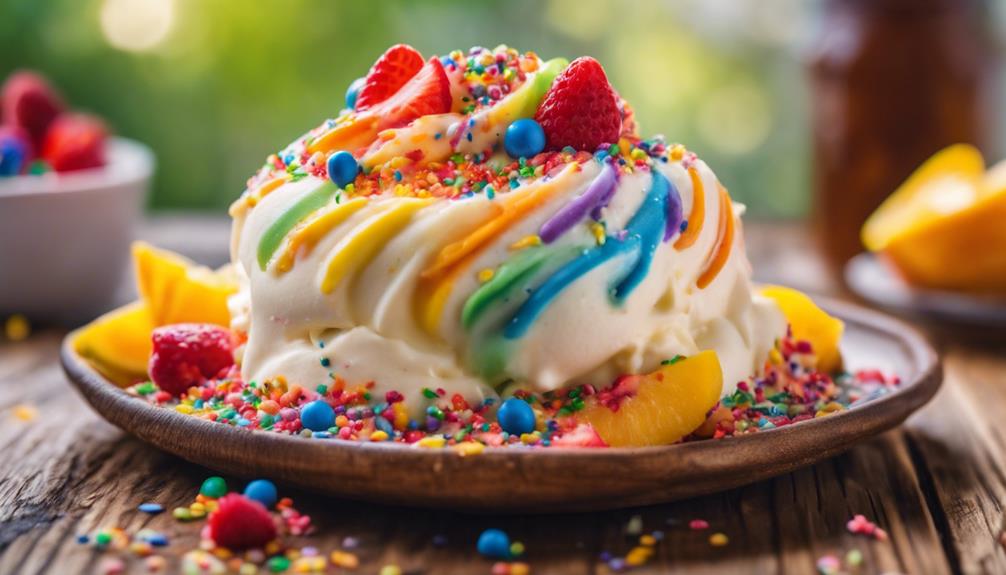
When it comes to Cake Batter Frozen Yogurt, you've got some great health options to ponder.
You can customize it to meet your dietary needs while keeping an eye on calories and nutritional benefits.
Let's explore how you can enjoy this treat without compromising your health goals.
Nutritional Benefits Overview
Cake batter frozen yogurt offers a nutritious alternative to traditional desserts, boasting around 127 calories and a high protein content that can fit well into your healthy eating plan. By using fat free Greek yogurt as a base, you not only reduce calories but also increase the protein content, making this treat a satisfying option.
Here are some key nutritional benefits:
- Low in calories: At around 127 calories per serving, it's a guilt-free dessert choice.
- High protein: Each serving can contain approximately 14 grams of protein, which helps with muscle repair and keeps you feeling full.
Incorporating ingredients like honey or agave helps maintain a creamy texture, ensuring you enjoy every spoonful.
With its rich taste and health benefits, cake batter frozen yogurt is a delightful way to satisfy your sweet tooth without compromising your nutrition.
Customization for Dietary Needs
Customization for cake batter frozen yogurt lets you tailor the recipe to meet specific dietary needs and preferences, ensuring everyone can enjoy this delicious treat.
If you're aiming for a healthier version, consider omitting added sugar or using sugar-free alternatives. You can also choose between full-fat Greek yogurt and cream cheese for a creamier texture, or opt for fat-free versions to lower the fat content while still enjoying a satisfying treat.
For those who are lactose intolerant or following a vegan diet, non-dairy alternatives like coconut yogurt and vegan cream cheese are fantastic options.
You can boost the nutritional profile even further by incorporating protein powder into the mixture, enhancing the protein content and making your frozen yogurt a more filling option.
Additionally, consider adding unsweetened almond milk or nut butters for extra flavor and nutritional benefits without greatly altering the overall taste.
With these customization options, your cake batter frozen yogurt can cater to a variety of dietary needs, making it a versatile and enjoyable dessert for everyone.
Calorie Control Strategies
To enjoy cake batter frozen yogurt while keeping calorie counts in check, consider incorporating calorie control strategies that enhance flavor without unnecessary added sugars or fats. By making a few simple adjustments, you can savor a delicious treat while being mindful of your nutrition.
- Omit added sweeteners: Skip optional sugars to reduce calories while preserving the delightful taste of cake batter.
- Opt for fat-free ingredients: Use fat-free Greek yogurt and cream cheese to maintain a creamy texture without the added fat.
These strategies not only help you control calories but also make your frozen yogurt a more satisfying option that supports your dietary goals.
You'll enjoy a guilt-free indulgence that aligns with your health considerations. By being mindful of your choices, you can indulge in cake batter frozen yogurt while still prioritizing your caloric intake and protein needs.
Related Recipes
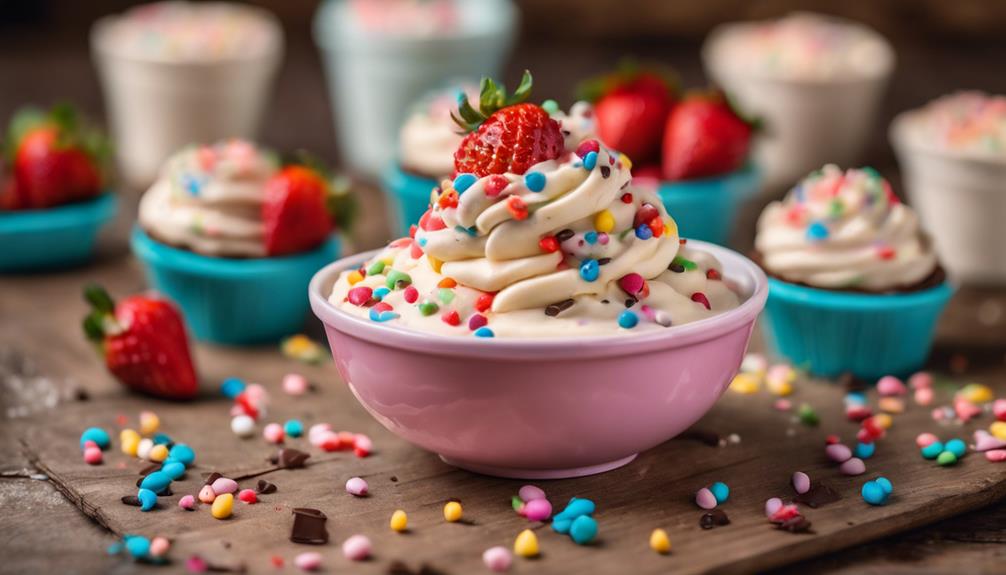
If you're craving more sweet delights, check out these related recipes that perfectly complement your Cake Batter Frozen Yogurt.
Start with the Cake Batter Cookie Brownies, which blend the rich taste of cake batter with a fudgy brownie texture. It's a unique dessert experience you won't want to miss.
You can also whip up some Funfetti Vanilla Cupcakes. These colorful treats, loaded with sprinkles, are perfect for celebrating special occasions or simply satisfying a sweet tooth. They pair beautifully with your frozen yogurt, creating a delightful dessert duo.
For a healthier option, consider making Healthy 10-Minute Chocolate Frozen Yogurt. This quick treat not only complements the cake batter flavor but also adds a rich chocolate twist to your dessert table.
If you're feeling adventurous, try your hand at No-Churn Artisanal Ice Cream. This recipe allows you to experiment with various flavors and textures without needing an ice cream machine, making it accessible for everyone.
With over 100 frozen treat recipes available, you'll find plenty of opportunities to express your creativity and customize your sweet experience beyond just Cake Batter Frozen Yogurt!
User Engagement
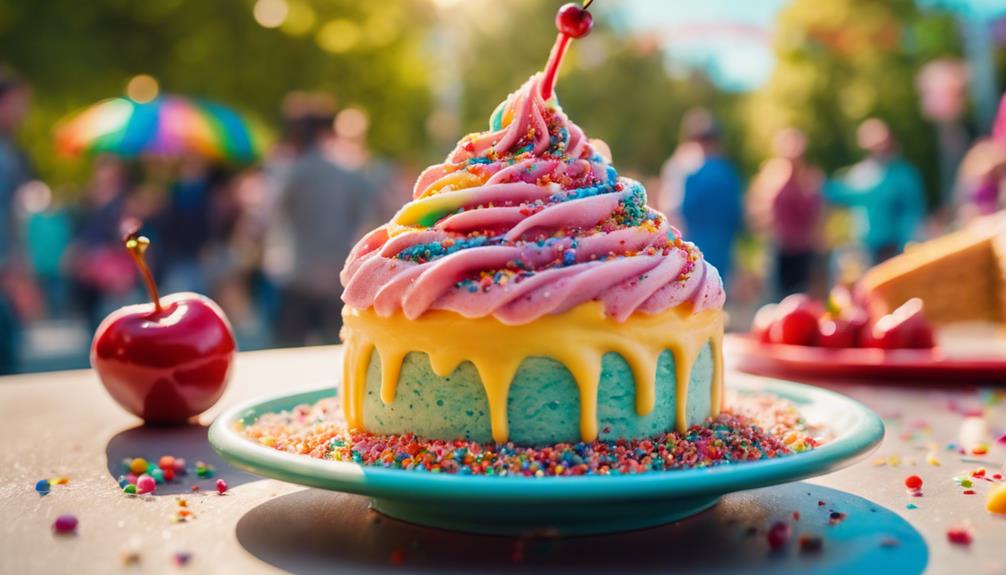
How can you make your experience with Cake Batter Frozen Yogurt even more enjoyable? Engaging with the recipe community can greatly enhance your enjoyment and creativity. By participating in user engagement activities, you not only contribute to the recipe's visibility but also gain valuable insights from others.
- Rate the Recipe: Share your thoughts through recipe ratings. Your feedback helps others discover the best variations and improvements.
- Join the Conversation: Use the comments section to share your personal experiences or adaptations. This fosters a supportive community where everyone can learn from each other.
Frequently Asked Questions
How Much Sugar Is in Cake Batter Frozen Yogurt?
The sugar content in cake batter frozen yogurt varies, but you'll typically find it ranges from 10 to 20 grams per serving. It's influenced by added sugars and sweeteners in the recipe.
Is Frozen Yogurt Considered Sweets?
Is frozen yogurt considered sweets? It's ironic, isn't it? You think of yogurt as healthy, but those creamy, indulgent flavors and added sugars make it a delightful dessert, satisfying your sweetest cravings.
What Does Adding Yogurt to Cake Mix Do?
Adding yogurt to cake mix makes your cake moister, denser, and richer. It activates leavening agents, creating a lighter texture, while also enhancing flavor and boosting nutrition with added protein and probiotics.
Is Frozen Yogurt a Healthy Dessert?
Yes, frozen yogurt can be a healthy dessert option for you. It's lower in fat and calories than ice cream, and you can customize it with nutritious toppings like fresh fruit and nuts. Enjoy responsibly!
Conclusion
You might think making cake batter frozen yogurt is too complicated, but it's actually super simple and fun.
With just a few ingredients and some blending, you can whip up a delicious treat that'll impress everyone.
Plus, it's a great way to indulge your sweet tooth without the guilt of traditional ice cream.
So, gather your friends or family, and create this delightful dessert together—it's not just about the yogurt; it's about making sweet memories!
